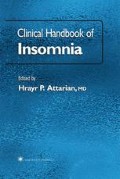Abstract
The American Academy of Sleep Medicine (AASM; previously the American Sleep Disorders Association [ASDA]) classifies poor sleep hygiene-induced insomnia as one of the 13 extrinsic sleep disorders in the 1997 revised edition of the International Classification of Sleep Disorders (ICSD) (1). Inadequate sleep hygiene and extrinsic sleep disorders are those sleep disorders caused or maintained by forces outside the body, as opposed to intrinsic sleep disorders (e.g., narcolepsy, obstructive sleep apnea syndrome or psychophysiologic insomnia), which are conditions where the pathophysiology depends on factors within the body. In extrinsic sleep disorders, external factors are primarily responsible for producing the symptoms. Removal of these factors is the first step of treatment and almost always ameliorates if not completely resolves the disorder. Although the distinction between intrinsic and extrinsic sleep disorders is clear, the two may co-exist and/or interact in an individual patient. Volitional extrinsic factors may initiate the processes responsible for the development of some intrinsic sleep disorders, becoming internalized as the disorder develops. For example, psychophysiological insomnia can develop after years of extrinsic sleep-destroying habits collectively known as inadequate or poor sleep hygiene. Sleep hygiene refers to one’s engaging in a set of behaviors that are conducive to falling asleep and staying sleep and abstaining from behaviors that are not. For example, intake of caffeinated beverages very close to bedtime produces insomnia resulting from caffeine’s stimulating properties, thus constituting poor sleep hygiene. Setting aside relaxation or “down time” prior to going to bed facilitates sleep, therefore making it an element of good sleep hygiene.
Access this chapter
Tax calculation will be finalised at checkout
Purchases are for personal use only
Preview
Unable to display preview. Download preview PDF.
References
American Sleep Disorders Association. (1997) International classification of sleep disorders: diagnostic and coding manual. American Sleep Disorders Association, Rochester, MN.
Manni, R., Ratti, M. T., Marchone, E., et al. (1997) Poor sleep in adolescents: a study of 869 17- year-old Italian secondary school students. J. Sleep Res. 6 (1), 44–49.
Schnelle, J. F., Cruise, P. A., Alessi, C. A., Ludlow, K., al-Smarrai, N. R., and Ouslander, J. G. (1998) Sleep hygiene in physically dependent nursing home residents: behavioral and environmental intervention implications. Sleep 21 (5), 515–523.
Schnelle, J. F., Alessi, C., A., al-Samarrai, N. R., Fricker, R. D. Jr., and Ouslander, J. G. (1999) The nursing home at night: effects of an intervention on noise, light, and sleep. J. Am. Geriatr. Soc. 47 (4), 430–438.
Martinez-Manzano, C. and Levario-Carrillo, M. (1997) [The efficacy of sleep hygiene measures in the treatment of insomnia]. Gac. Med. Mex. 133(1), 3–6.
Friedman, L., Benson, K., Noda, A., et al., (2000) An actigraphic comparison of sleep restriction and sleep hygiene treatments for insomnia in older adults. J. Geriatr. Psychiatry Neurol. 13 (1), 17–27.
Kageyama, T., Kabuto, M., Netta, H., et al., (1997) A population study on risk factors for insomnia among adult Japanese women: a possible effect of road traffic volume. Sleep 20 (11), 963–971.
Onen, S. H., Onen, F., Bailley, D., and Parquet, P. (1994) [Prevention and treatment of sleep disorders through regulation] of sleeping habits]. Presse Med 23(10), 485–489.
Ulfberg, J., Carter, N., Talback, M., and Edling, C. (2000) Adverse health effects among women living with heavy snorers. Health Care Women Int. 21 (2), 81–90.
Ibata, Y., Okamura, H., Tanaka, M., et al. (1999) Functional morphology of the suprachiasmatic nucleus. Front. Neuroendocrinol. 20 (3), 241–268.
Bonnet, M. H. and Arand, D. L. (1996) The consequences of a week of insomnia. Sleep 19 (6), 453–461.
Bonnet, M. H. and Arand, D. L. (1998) The consequences of a week of insomnia. II: Patients with insomnia. Sleep 21 (4), 359–368.
Hauri, P. J. (1998) Insomnia. Clin. Chest Med. 19 (1), 157–168.
Domino, G., Blair, G., and Bridges, A. (1998) Subjective assessment of sleep by Sleep Questionnaire. Percept. Mot. Skills 59 (1), 163–170.
Buysse, D. J., Reynolds, C. F., 3rd, Monk, T. H., Berman, S. R., and Kupfer, D. J. (1989) The Pittsburgh Sleep Quality Index: a new instrument for psychiatric practice and research. Psychiatry Res. 28 (2), 193–213.
Blake, D. D. and Gomez, M. H. (1998) A scale for assessing sleep hygiene: preliminary data. Psychol. Rep. 83 (3 Pt 2), 1175–1178.
Chesson, A., Jr., Hartse, K., Anderson, W. M., et al. (2000) Practice parameters for the evaluation of chronic insomnia. An American Academy of Sleep Medicine report. Standards of Practice Committee of the American Academy of Sleep Medicine. Sleep 23 (2), 237–241.
Laube, I., Seeger, R., Russi, E. W., and Bloch, K. E. (1998) Accidents related to sleepiness: review of medical causes and prevention with special reference to Switzerland. Schweiz. Med. Wochenschr. 128 (40), 1487–1499.
Philip, P., Taillard, J., Guilleminault, C., Quera Salva, M. A., Boulac, B., and Ohayon, M. (1999) Long distance driving and self-induced sleep deprivation among automobile drivers. Sleep 22 (4), 475–480.
Lacks, P. and Rotert, M. (1986) Knowledge and practice of sleep hygiene techniques in insomniacs and good sleepers. Behav. Res. Ther. 24 (3), 365–368.
Editor information
Editors and Affiliations
Rights and permissions
Copyright information
© 2004 Springer Science+Business Media New York
About this chapter
Cite this chapter
Attarian, H.P. (2004). Sleep Hygiene. In: Attarian, H.P. (eds) Clinical Handbook of Insomnia. Current Clinical Neurology. Humana Press, Totowa, NJ. https://doi.org/10.1007/978-1-59259-662-1_9
Download citation
DOI: https://doi.org/10.1007/978-1-59259-662-1_9
Publisher Name: Humana Press, Totowa, NJ
Print ISBN: 978-1-61737-465-4
Online ISBN: 978-1-59259-662-1
eBook Packages: Springer Book Archive

